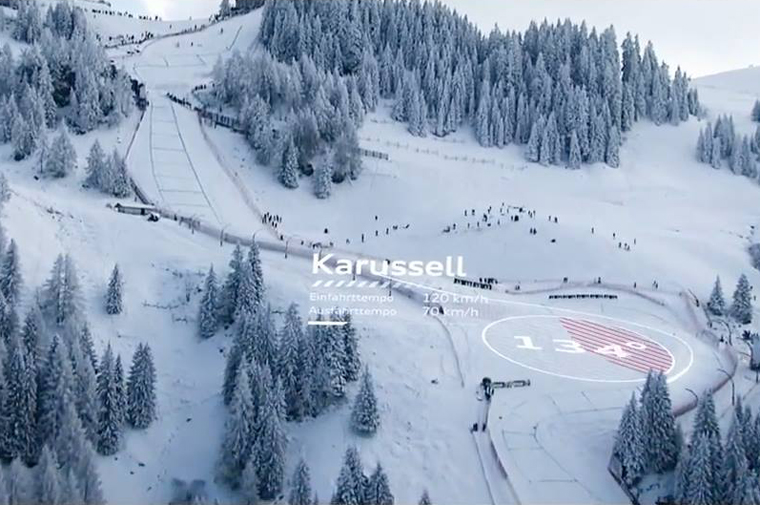The physics of skiing Kitzbühel’s legendary Streif race course


The Hahnhenkamm race in Kitzbühel is without a doubt the most iconic, prestigious, and even feared event on the ski racing calendar. The DH course itself is known as the Streif (Hanhenkamm is the name of the mountain), and is terrifyingly steep, laced with huge jumps and brutal compressions. The bulletproof snow – injected with water to make it even harder and faster – is glazed like blue ice; competitors can reach speeds of over 140km/h while fighting for balance over the rutted and canted surface. A win on the Streif is enough to cement a skiers name into legend. A mistake can – and has – result in serious injury.
From the extremely steep start down to the valley, the skiers have to overcome 860 vertical metres and more than 3.3 km of distance, at times over 85% (40°) steep. Three of the most daunting sections are known as the Mausefalle, Steilhang and Hausbergkante, difficult enough to test the mettle and muscle of even the most elite ski racers. In the following videos former ski racer and Streif winner Daron Rahlves (USA) explains the physical forces the athletes are exposed to during their daredevil ride down the Streif.
The first key part of the run is “Mausefalle”. An 85% decline and 60- to 80-metre jumps expect the downhillers. “If you don’t absorb this jump, you will explode on the bottom of the Mausefalle,” Rahlves describes the challenge. “The steep fall line pushes your speed up to 130km/h, heading straight into the compression.”
Physics of Racing – Kitzbühel, Streif – Mausefalle
Physics of Racing – Kitzbühel, Streif – Mausefalle with Daron Rahlves
After the Mausefalle, the 85% steep Steilhang is the second crux move of the Streif run. It demands total commitment, focus and sensitivity. The most challenging right turn of the course follows just after at high speed, the steeply canted slope pushing the skiers right up to the safety net.
Physics of Racing – Kitzbühel, Streif – Steilhang
Physics of Racing – Kitzbühel, Streif – Steilhang with Daron Rahlves
With Mausefalle and Steilhang out of the way, racers have to cope with the extremely demanding final part of the run. The perfect entrance line to the Hausbergkante is key, and the ideal point for the jump sits only a few centimetres from the inner gate. Coming up next are the rough bumps and rollers of the Traverse, torture for screaming leg muscles, which leads into the Zielsprung (final jump) and Zielschuss (final schuss) before the participants cross the finish line at up to 140 kph.
Physics of Racing – Kitzbühel, Streif – Hausbergkante
Physics of Racing – Kitzbühel, Streif – Hausbergkante with Daron Rahlves